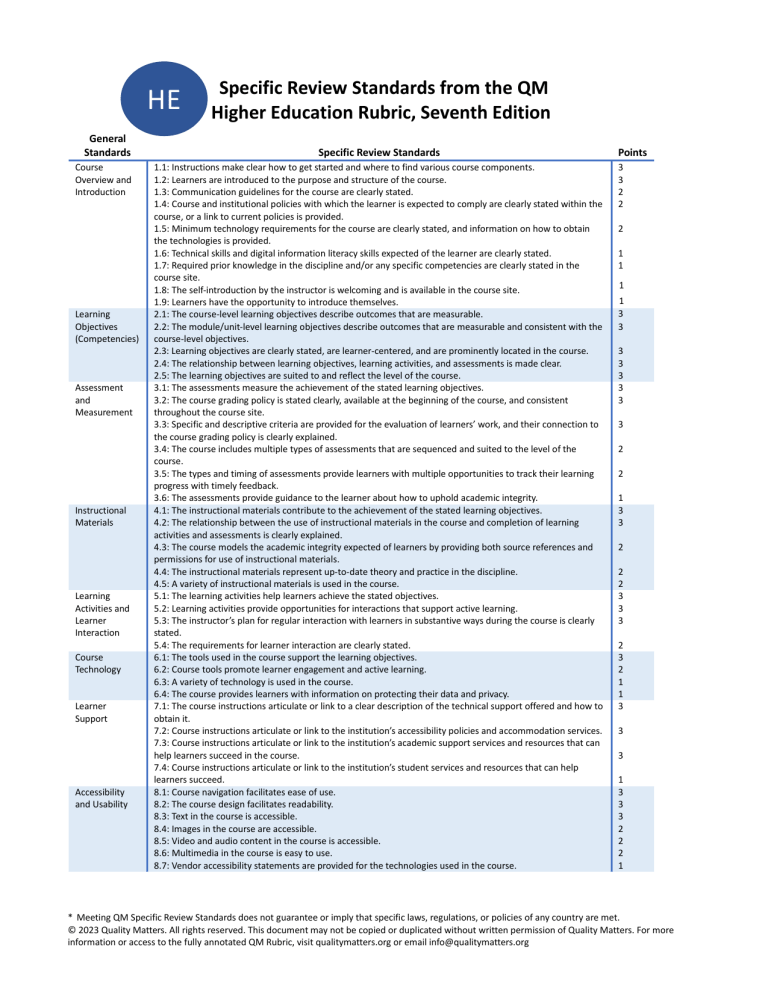
HE General Standards Course Overview and Introduction Learning Objectives (Competencies) Assessment and Measurement Instructional Materials Learning Activities and Learner Interaction Course Technology Learner Support Accessibility and Usability Specific Review Standards from the QM Higher Education Rubric, Seventh Edition Specific Review Standards 1.1: Instructions make clear how to get started and where to find various course components. 1.2: Learners are introduced to the purpose and structure of the course. 1.3: Communication guidelines for the course are clearly stated. 1.4: Course and institutional policies with which the learner is expected to comply are clearly stated within the course, or a link to current policies is provided. 1.5: Minimum technology requirements for the course are clearly stated, and information on how to obtain the technologies is provided. 1.6: Technical skills and digital information literacy skills expected of the learner are clearly stated. 1.7: Required prior knowledge in the discipline and/or any specific competencies are clearly stated in the course site. 1.8: The self-introduction by the instructor is welcoming and is available in the course site. 1.9: Learners have the opportunity to introduce themselves. 2.1: The course-level learning objectives describe outcomes that are measurable. 2.2: The module/unit-level learning objectives describe outcomes that are measurable and consistent with the course-level objectives. 2.3: Learning objectives are clearly stated, are learner-centered, and are prominently located in the course. 2.4: The relationship between learning objectives, learning activities, and assessments is made clear. 2.5: The learning objectives are suited to and reflect the level of the course. 3.1: The assessments measure the achievement of the stated learning objectives. 3.2: The course grading policy is stated clearly, available at the beginning of the course, and consistent throughout the course site. 3.3: Specific and descriptive criteria are provided for the evaluation of learners’ work, and their connection to the course grading policy is clearly explained. 3.4: The course includes multiple types of assessments that are sequenced and suited to the level of the course. 3.5: The types and timing of assessments provide learners with multiple opportunities to track their learning progress with timely feedback. 3.6: The assessments provide guidance to the learner about how to uphold academic integrity. 4.1: The instructional materials contribute to the achievement of the stated learning objectives. 4.2: The relationship between the use of instructional materials in the course and completion of learning activities and assessments is clearly explained. 4.3: The course models the academic integrity expected of learners by providing both source references and permissions for use of instructional materials. 4.4: The instructional materials represent up-to-date theory and practice in the discipline. 4.5: A variety of instructional materials is used in the course. 5.1: The learning activities help learners achieve the stated objectives. 5.2: Learning activities provide opportunities for interactions that support active learning. 5.3: The instructor’s plan for regular interaction with learners in substantive ways during the course is clearly stated. 5.4: The requirements for learner interaction are clearly stated. 6.1: The tools used in the course support the learning objectives. 6.2: Course tools promote learner engagement and active learning. 6.3: A variety of technology is used in the course. 6.4: The course provides learners with information on protecting their data and privacy. 7.1: The course instructions articulate or link to a clear description of the technical support offered and how to obtain it. 7.2: Course instructions articulate or link to the institution’s accessibility policies and accommodation services. 7.3: Course instructions articulate or link to the institution’s academic support services and resources that can help learners succeed in the course. 7.4: Course instructions articulate or link to the institution’s student services and resources that can help learners succeed. 8.1: Course navigation facilitates ease of use. 8.2: The course design facilitates readability. 8.3: Text in the course is accessible. 8.4: Images in the course are accessible. 8.5: Video and audio content in the course is accessible. 8.6: Multimedia in the course is easy to use. 8.7: Vendor accessibility statements are provided for the technologies used in the course. Points 3 3 2 2 2 1 1 1 1 3 3 3 3 3 3 3 3 2 2 1 3 3 2 2 2 3 3 3 2 3 2 1 1 3 3 3 1 3 3 3 2 2 2 1 * Meeting QM Specific Review Standards does not guarantee or imply that specific laws, regulations, or policies of any country are met. © 2023 Quality Matters. All rights reserved. This document may not be copied or duplicated without written permission of Quality Matters. For more information or access to the fully annotated QM Rubric, visit qualitymatters.org or email info@qualitymatters.org



